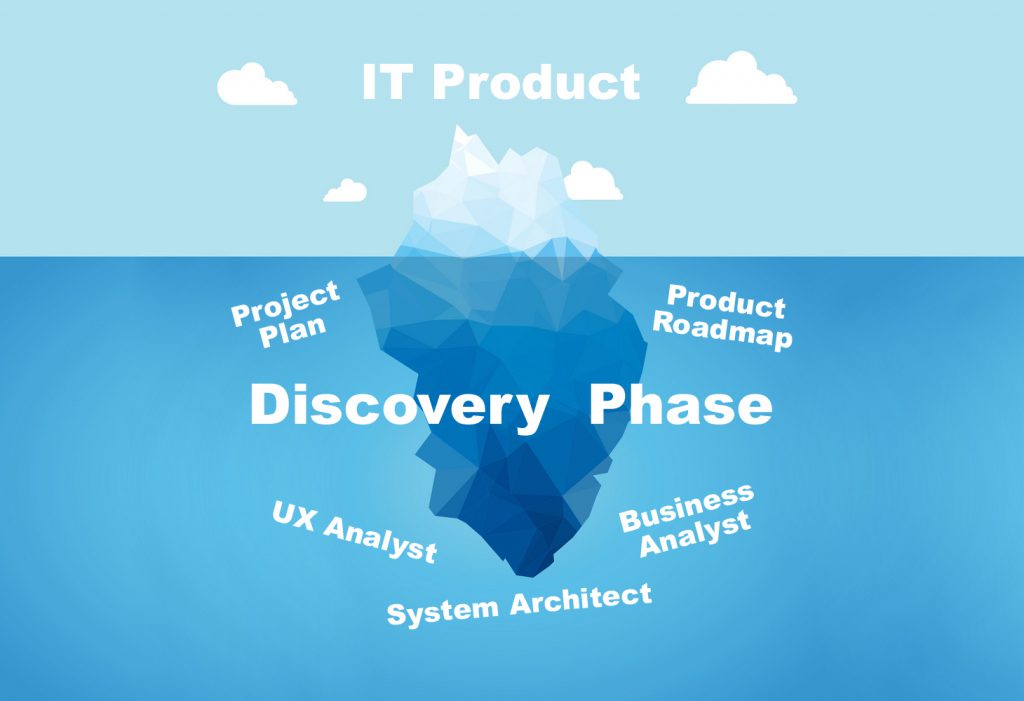In this article we describe the importance of the Discovery phase in a project, focusing on its benefits and illustrate ZenBit’s discovery project approach.
What makes you confident in your software project development and gives value to its every step – design, code writing, testing, deployment, and support? Though often underestimated and treated as a luxury, a Project Discovery phase is essential for the project to be ready on time and within budget. Giving you a clear vision, careful planning, and an exact understanding of who needs it and what it solves, and what makes a difference, the Discovery phase saves from missed deadlines and additional expenses in later stages and defines success.
What is the Discovery phase?
In software product development Discovery phase is an investigation of the project. The process is not fast and usually lasts up to two months. The information is being collected and thoroughly studied, defining the target audience and market, visualizing the goals, range, and obstacles.
This stage is important for understanding what the end-users need or if there is a need at all, or maybe they need but can’t afford, etc.
The Discovery phase process ends up in the system requirements specification (SRS) list, the ground for the project development plan. For instance, significant deliverables, primary and additional features, less stress and more. You will also get a preliminary prototype to imagine how the project will look like, and the team line up and cost recommendation. So, the benefits are clear and crucial for business.
What an ideal project discovery phase should look like?
An effective discovery phase gives you time to turn uncertainty and doubts into clarity and confidence. The process includes the following:
- Discovery Initialisation
The discovery phase begins with establishing project strategy and objectives. You focus on the problem that is going to be solved by the project. The present situation of the product and the requirements are being considered. The issue your project is going to fix should be hot. Lots of attention to the timing, competitors, target audience, monetizing. Promotion strategy for reaching the customers. Possible ways of investment, like fundraising, etc. And the Unique Value Proposition (UVP) of the solution, of course.
- Research
Researching for Comparative evaluation, Technological restrictions, Industry standards and trends help to identify the strong and weak points of the current solutions. As a result, your product can find a suitable place in the market and you will have the knowledge of how to attract customers.
A comparative evaluation makes it possible to choose the best option from a set of possibilities. A list of criteria decided in advance is the ground for comparison and every potential option appears in the contrast of pros and cons. Numbers are great in making the comparison and selection process vividly obvious. For example, if we compare the price, the choice with the lower cost wins. Features of available choices are being contrasted by defining what is similar between them and what is different. Direct and indirect competitors are also investigated here as well as product analogues existing on the market. Ideas, subjective concerns, personal likes and dislikes, perspectives are also included in the process of comparative evaluation.
The project development process is likely to have several Technological restrictions. All the technological aspects, methods, platforms, procedures, etc that might badly influence your project development as well as a gap in knowledge on new technology or not enough skills and training. Seeing them coming and managing the best possible way is necessary for an effective project discovery. This is where most project managers’ efforts go. Otherwise, it can be the reason for delaying, extra expenses, or in the worst case, your epic failure. For example, the client intends to use cloud computing at some point but this is the feature your product doesn’t support. Very often technological restrictions are beyond your control.
Following industry standards is not a must-do. However, if you care about the best experience for your clients, and in some cases even legal security, you have no choice. For example, in the sphere of learning management systems, your product should meet the standards of SCORM (Sharable Content Object Reference Model) and AICC (Aviation Industry Computer-Based Training Committee) to satisfy each of your professional users, WCAG (Web Content Accessibility Guidelines) to make web content more reachable to people with disabilities and for legal security, IMS for proving your software is trustworthy, etc.
To stay competitive you should regularly adapt to the changes in the world around you, be flexible and innovative. Blockchain technology, digitalization, artificial intelligence, 5G, Internet of things, biometrics, 3D printing, quantum computing, virtual reality, robotic process automation, and other industry trends shape 2020-21 for entrepreneurs and small businesses. Many of them apply to any market and they are not necessarily all technological. Global warming, gender equality issues to address are highly expected from brands and Generation Z clients will pay up to two times more for sustainable products.
- Requirements elicitation
No matter what the type of your project is, it is going to have its formal and informal requirements that come from different sources. But defining the requirements is not enough, being able to keep them from changing is another project managers’ superpower for planning and executing your project.
In the Persona & Use case building the focus is on Who and How – the types of individuals who are going to use your final product and the possible ways they reach a goal while using the software system. A use case is a sort of communication between a system and its users (actors). For example, in an automated order system, users need to check if the item is available, compare two items, change or cancel the order. Describing the actors by what interactions they want to perform with the system leads to defining and differentiating the actors.
Usage statistics are also being evaluated at this stage and big interest goes to the workflow analysis, the process of studying the progression of workflows for improved performance. They are the essence of any project and show the way it should be created and set up.
Key Performance Indicators (KPIs) are defined to focus your attention on the most important things for making project strategy and functioning better, to create the ground for reasonable decisions. For example, KPIs in finance are growth in revenue, net profit margin, operational cash flow, gross profit margin, etc. First, you check business objectives, and study the current efficiency, then fix short and long term KPI goals, discuss targets with your colleagues, regulate and adapt progress.
In the project discovery phase, you have to identify all stakeholders’ needs and goals so that they are a vital part of the project development, planning, performance, and estimation.
- Interaction Design
Your final product usage should be easy and yet inviting. This is the reason why an interaction design strategy is divided into physical and emotional interaction concepts. Generated interaction concepts are supposed to ensure relevant and smooth users’ experiences.
For having better insights on how the process works, you need to make the process and flow diagrams. It will make everything clear and standardized for the whole team when there are no double meanings or vague options and every person sees the same image. As soon as the project development process is represented on a diagram, new improvements may be born, such as removing or automating certain steps. The process and flow diagrams can show inputs and outputs, participants, necessary decisions and actions, time, numbers, etc.
Wireframing is very helpful in showing how the items are arranged on a screen and demonstrating which of them need to be based on user preferences and needs.
Creating Interactive prototypes is important for testing if the product is usable. They may be super simple, created very fast in PowerPoint or Exel, or a digital sophisticated prototype, interactive and animated, that already looks like a final product.
- Visual design
Following the design guidelines is crucial for creating a pleasant user experience – easy to learn, intuitive, consistent and efficient. Common sense is often the main judge here. For example, your client can complain right away that a webpage looks overloaded. So, the solution should be made on how to improve it and the focus goes to layout, style, text, design patterns, accessibility, user interface components, etc. Design guidelines depend on the context, culture, space available, and type of interaction of course, but in most cases, it is all about bringing the cognitive load to a minimum while improving readability.
UI Kit does wonder in giving your project some creative boost. Saving time and efforts, it helps to create a complete and reliable website with an awesome design. You can find wonderful CMS-ready UI kits on the Internet, design in your way, fill with your content and here we are – in a few times the site is ready to launch. Forest, Ollie, Quichsmart, Timber, Fortis, Prospero, and many others – the choice is yours.
- Planning
Clear and relevant requirements specification leads to creating the right product. It would be great if you write a document defining the reasons why people need your product, give a description of what you are engineering, provide detailed requirements, and get the approval. It may seem difficult but once the Outline is created, further filling it out is not a problem at all. Your basic document should include Introduction with the purpose, scope, target audience and use, General Description of user needs, assumptions and dependencies, and System Features and Requirements.
Roadmap planning software is very popular nowadays, and you can choose from a rich variety of tools. Just make sure you study the sets of features in each one and choose what you need the most. Hello Focus, Roadmap Planner, ClickUp, Craft, Hygger, SharpCloud, and many others make the collaboration easier, frame the process, and help bring projects to life on time.
The effectiveness of your project performance on its every phase depends on time/budget estimations. For example, before creating an app you investigate how much materials will cost as well as professionals’ work. The team created, office equipment bought, time to consider travel expenses, software licenses, expert fees, insurance, and administration. Every project has its fixed items and things that are not expected at the beginning, so it will make you feel safer if you leave a place for them in your budget too. Make sure you include planned vs actual columns.
Every step of your project needs strict deadlines and timeframes. With an accurate time estimation, you can see realistic project expectations, define possible risks, better organize processes, and focus on the priority tasks. So, you start with the amount of work – write a detailed list of activities and determine how much time each step may take. If you can afford, add some extra time for anything unexpected that might happen during the process.
What will be the deliverables of the discovery phase?
So, you did a lot of initial work and now you are armed with project discovery phase deliverables, the keys to your final product success. They usually vary depending on the project complexity, size, stage, and deadlines. Taking into account the needs of the project at a particular time, the discovery phase deliverables are:
- Product Concept – The image of your final product quality, innovative features, or performance. The focus is not so much on the production and business output but the client.
- Architecture solution – A program, project, or change that is ready for immediate implementation, a structural design that is relevant to necessary conditions.
- Software requirements specification (SRS Document) – An accurate description of the project, final product features, recommended technology, and architecture plan. The document should be evaluated and discussed for possible improvements before approval.
- Road Map – A graphical, extra quality sketch of the project’s goals, dependencies, and risks demonstrated on a timeline. With no abundance of unnecessary details, the road map is great for seeing stakeholders’ needs and finding ways to please them. The Road map is also a comfortable connection between teams where plans are communicated without much effort and resources are easily coordinated.
- Visual concept – The development team hasn’t started doing the job yet, but you already have your first impression of the interface design and its primary features.
- Time/budget estimations – The final numbers obtained during the discovery phase proved to be reliable and unlikely to change. Your emotional confidence will ensure a recommended team lineup so that your time and money are safe.
What is an agile approach in project development?
A fast-paced agile approach is a popular way to manage work in the modern world full of changes. It focuses on the ability of quick adaptation and has its values and principles where everything human is always above technology, responding to changes is above following the plan, etc. The highest priority here is to satisfy the customer and changing requirements are welcomed. Frequent project delivery, daily coordination, motivating environment and support, face-to-face communication, sustainable development, technical excellence, and nice design, simplicity, self-organizing teams are agile guidelines in making the right project development decisions.
Discovery phase in agile
The Agile methodology is associated with a no-time-to-lose way of working, and in this case, the Discovery phase in a project might seem out of place. However, it is usually considered as one of the main priorities because there is no other way to ensure mutual understanding between professionals from the start.
What is the benefit of discovery in agile?
Discovery in Agile empowers your project with fluency and the freedom to adapt to possible changes due to what was missed or situations that are out of your control. The fact is, in agile projects discovery is continuous and it remains in every step ready for improvement. So, implementing new requirements is easy and effective. You can initiate a simple discovery to describe the project’s goal and gradually connect systems along with each stage.
ZenBit’s approach of providing Discovery Phase
Since 2017, we have managed to help our most enthusiastic clients make their dreams come true bringing their brilliant ideas to life. We value time and product passion, following certain business principles of quality delivery, that’s we care a lot about the Discovery phase. We split it into several major modular stages
First stage – What we are going to achieve
- Define product objectives and KPIs – Plan, profit, delivering new products on time and budget, achieving product quality levels, and customer satisfaction are our objectives. KPIs data will measure performance, monitor success, and be a guideline for further business direction.
- Competitive Researching and market analysis – We carefully investigate the market to find clients for your business. The competitive analysis gives a lot to its uniqueness. The result is your product’s competitive advantage.
- RoadMap – We use it for visualizing goals, steps, and milestones. A roadmap proved to be a great communication tool.
Second stage – Technical stage
- Software requirements specification (SRS Document) – We create a high-level document that illustrates what the program will do and how it is supposed to function. It also focuses on the needs of all stakeholders.
- Architecture solution – We create a comprehensive architecture for a software solution and provide strategic direction throughout the development process. For doing this our professionals have a perfect technical background and analytical skills, excellent communication, project, and resource management experience.
Third stage – Visual Part
- Process and flow diagrams – We create a process diagram to show what the project discovery phase consists of where each activity is marked by the correct symbol and connections are made between them according to the timeline. It is a nice arrangement illustration. Flow diagram, on the other hand, shows a set of dynamic relationships in a system. It is usually a flowchart with shapes that represent different kinds of processes.
- Wireframing – We use wireframing to design your product at the structural level. Content and functionality are represented on a page with user needs and user journeys.
- Visual concept including Design guidelines, UI Kit – We follow design guidelines keeping the interface simple, page layout deliberate, purposefully using color and texture, hierarchy and clarity, creating consistency, and using common UI elements. We also have our UIkit that saves a lot of time when creating user interface components.
- Interactive prototypes – We like quickly created wireframes for early testing and stakeholder evaluations. They can be either animation, rapid prototypes, storyboards, or simulations.
Fourth stage – Development Planning
- Time/budget estimations – We pay a lot of attention to define how much time is needed to fulfill each step of the project.
- Breaks down a product’s functionality into deliverables – Everything is easier if you divide each step of your project into small tasks. So we build an understandable structure of the project that all stakeholders can appreciate.
- Applying and configuring suitable project management methodology – We need to select the most suitable project management methodology to make the most of the available resources and time. So we chose either Waterfall, Agile, eXtreme Programming (XP) or Kanban, Lean, and others. Everything depends on the project.
All these modules are completely independent so we can help at any stage of the product.

Conclusion
So what is the ideal discovery phase and how it will help you save time, budget, scale down development risks, and avoid common pitfalls? Overconfidence and the wish to deliver frequently should be balanced with knowing where you are going, otherwise, you just won’t get there. A good beginning makes a good ending. If your initial stage is chaotic and wrong, a lot of time and money will be lost in the end. But if you begin the right way, investing at the seed step, you will enjoy watching the process go naturally and fluently.
The Discovery phase gives great value to your project by framing the problem, searching for possible solutions as well as bringing the developers team to an easy agreement where everyone has a clear vision of the goal and its steps. It helps to reduce the project budget in general and ensures meeting the deadline in time.
No secret that all profitable projects have focused a lot on project discovery. You can benefit from the experience of others and trust to focus on the initial step more. Don’t hesitate and use the Discovery phase as the superpower on the way to your business success.





